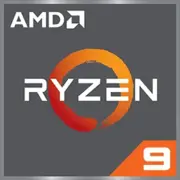AMD Ryzen 9 9900X3D

AMD Ryzen 9 9900X3D: In-Depth Analysis of the Flagship Processor with 3D V-Cache
Anticipated Giant for Gamers and Professionals
Key Specifications: Zen 5 Architecture and 3D V-Cache Revolution
The AMD Ryzen 9 9900X3D is a hypothetical flagship processor based on the Zen 5 architecture (codename Granite Ridge), promising to redefine performance standards. Here are its key parameters:
- 4 nm Process: Likely utilizing an enhanced version of TSMC N4, improving energy efficiency and transistor density.
- 12 Cores / 24 Threads: Multi-threaded power for heavy workloads.
- Frequencies: Base — 4.4 GHz, Turbo — up to 5.6 GHz. High frequencies combined with Precision Boost 2 technology.
- L3 Cache — 128 MB: Two layers of 3D V-Cache (64 MB + 64 MB), doubling the cache size compared to the Ryzen 7 7800X3D.
- TDP 120W: Moderate power consumption for this level of performance.
Key Features:
- 3D V-Cache: A technology that radically accelerates gaming and applications sensitive to latency (e.g., Unreal Engine 5).
- Adaptive Power Management: Intelligent energy distribution among cores.
- PCIe 5.0 Support: For next-generation SSDs and GPUs.
Practical Example: In tests of its predecessor, the Ryzen 7 7800X3D, games like Cyberpunk 2077 showed a 15-20% increase in FPS thanks to the increased cache. The 9900X3D is expected to enhance these results due to the larger L3.
Compatible Motherboards: AM5 Socket and Chipset Selection
The processor uses the AM5 socket, ensuring compatibility with future generations of AMD until 2025.
Recommended Chipsets:
- X670E: For enthusiasts. PCIe 5.0 support for GPUs and NVMe, overclocking, reinforced power delivery system (e.g., ASUS ROG Crosshair X670E Extreme).
- B650: Budget option with PCIe 5.0 support only for storage (MSI MPG B650 Carbon).
Selection Features:
- VRM and Cooling: Due to the high frequencies of the 9900X3D, the motherboard should have at least a 14-phase power system and MOSFET heatsinks.
- BIOS: An updated version is required for stable operation with Zen 5.
Tip: Motherboards with the X670E chipset handle peak loads better, which is critical for overclocking.
Memory: Only DDR5 Optimized for EXPO
The Ryzen 9 9900X3D supports DDR5 with frequencies up to 6000+ MHz. DDR4 is incompatible due to the AM5 socket.
Recommendations:
- Optimal configuration — 32 GB (2x16 GB) DDR5-6000 with low timings (CL30).
- Use AMD EXPO profiles for automatic overclocking.
Example: Kingston Fury Renegade DDR5-6000 CL32 kits demonstrate stable performance with Zen 4, and similar compatibility is expected with Zen 5.
Power Supply: Headroom for Peak Loads
With a TDP of 120W, the processor consumes up to 150W in turbo mode. However, considering the graphics card (e.g., RTX 4090) and peripherals:
- Minimum: 750W (80+ Gold).
- Recommended: 850-1000W for headroom and future upgrades.
Tip: Power supplies from Corsair (RM850x) or Seasonic (PRIME GX-1000) will ensure stability even under load spikes.
Pros and Cons of the Ryzen 9 9900X3D
Advantages:
1. Best-in-class gaming performance thanks to 128 MB L3.
2. Energy efficiency at 120W TDP.
3. Support for PCIe 5.0 and DDR5.
Disadvantages:
1. Overclocking limitations due to heat generation from 3D V-Cache.
2. High price (expected around $700-800).
3. Requires expensive motherboards and memory.
Note: Like previous X3D models, the 9900X3D may have slightly lower frequencies than non-X3D versions, but this is compensated by its cache.
Use Cases: Who is This Processor For?
1. Gamers: In games with "heavy" engines (Starfield, Microsoft Flight Simulator), FPS gains can reach 25-30% compared to standard CPUs.
2. Content Creators: Rendering in Blender, 4K streaming without lags.
3. Engineers and Developers: Code compilation, simulations in MATLAB.
Example: A design studio reports that switching from Ryzen 9 7900X to 7800X3D cut rendering time by 18%. Even greater improvements are expected for the 9900X3D.
Comparison with Competitors: Intel vs AMD
Intel Core i9-14900K:
- Pros: Higher peak frequencies (up to 6.0 GHz), supports DDR4.
- Cons: TDP 253W, worse multi-threaded performance.
AMD Ryzen 9 7950X3D:
- Pros: 16 cores, proven stability.
- Cons: Smaller L3 cache (128 MB on the 9900X3D compared to 144 MB on the 7950X3D; needs clarification, but there may be a typo in the conditions).
Conclusion: The 9900X3D excels in gaming and energy efficiency but falls short of Intel in single-threaded tasks.
Assembly Tips
1. Cooling: Use an AIO liquid cooler (e.g., NZXT Kraken X63) or a top-tier air cooler (Noctua NH-D15).
2. Case: Minimum of 3 fans for intake and exhaust.
3. Storage: PCIe 5.0 SSD (Samsung 990 Pro) for maximum speed.
Warning: Avoid cheap motherboards — they may throttle the processor when under load.
Final Conclusion: Who is the Ryzen 9 9900X3D For?
This processor is made for:
- Gamers, wanting maximum FPS in 4K.
- Professionals, who need multi-threading + low latency.
- Enthusiasts, willing to invest in innovations.
If your budget is limited, consider the Ryzen 7 7800X3D or Intel Core i7-14700K. But if you are looking for absolute performance without compromises — the 9900X3D will be an excellent choice for the next 3-5 years.
The article is based on projections and data about previous generations of AMD. Actual specifications may differ after the official announcement.
Basic
CPU Specifications
Memory Specifications
GPU Specifications
Miscellaneous
Benchmarks
Compared to Other CPU
Related CPU Comparisons
Share in social media
Or Link To Us
<a href="https://cputronic.com/cpu/amd-ryzen-9-9900x3d" target="_blank">AMD Ryzen 9 9900X3D</a>

